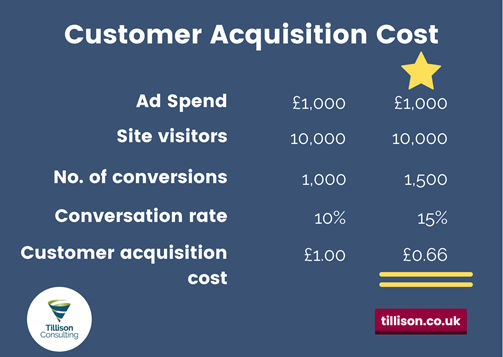Are you generating a decent amount of traffic to your website but getting poor sales results? eCommerce stores famously spend a lot of money on paid advertising (PPC) and spend a lot of time getting their sites higher in the search results (SEO). However, the work doesn’t stop there.
To maximize PPC and SEO results, site owners need to optimize conversion rates. This means turning visitors into paying customers. So what are the overriding benefits of conversion rate optimisation? Let’s dig in.
What Is Conversion Rate Optimization?
You’ve got visitors to your landing page either through an excellent pay-per-click campaign or SEO best practice. But encouraging them to take the desired action on the page, or ‘convert,’ can prove rather tricky.
This is why we measure the proportion of users who go on to make a purchase or become a lead. It’s a simple calculation: the number of site visitors that convert is divided by the total number of visitors and multiplied by 100.

Formula for calculating conversion rate.
Many things may cause visitors to leave your site without converting. A slow site speed, poor product images, or an unclear call to action are just a few of the reasons your landing page may not be performing as well as you would like.
You should always look at ways to improve your website and the overall online customer journey – a practice known as ‘conversion rate optimization’ or ‘CRO.’ This involves making subtle changes to your landing page to see what has it performing the best.
What Are the Benefits of Conversion Rate Optimization?
1. Understand Your Customers Better
To generate sales or leads, you must have a firm understanding of your customers. A large part of the research process that is included in CRO involves your customers. You’ll learn exactly who your customers are and how they interact with your website. It’ll also help you ferry them through the sales funnel and identify the aspects of your site that stop them from converting.
2. Maximize Paid Advertising Results
As briefly touched on, running a pay-per-click campaign is a sure-fire way to drive visitors to your website. You’re paying for every click through to your website, so you want to make them count.
However, it’s not good to attract traffic if you’ve got a substandard landing page. When it comes to maximizing paid advertising results, we need to look at the customer acquisition cost – and an increase in conversion rate will go a long way in lowering how expensive it is to win a purchase or lead.
For example, let’s look at what would happen if you were to have a paid campaign with a budget of £1,000, which drove 1,000 visitors to your website.

The improvement of customer acquisition cost through an improved conversion rate.
3. Make More Informed Decisions
When you’re investing your time and money into creating content and running ad campaigns, you cannot afford to make guesses. You want every decision you make to be based upon facts and figures. When you have such data laid out before you, you can make better, more informed decisions.
A/B Testing\
A/B testing makes up a large part of CRO. This is the process of creating two different versions of the same page and displaying them in front of two similar audiences of the same size to discover which one comes out on top. This allows you to choose a version that you can be pretty sure will perform better.

A comparison of two different versions of the same page.
4. Improve Your Search Rankings
You would be forgiven for thinking of search engine optimization (SEO) and CRO as two entirely unrelated strategies. However, adopting each approach hand-in-hand will produce some excellent results.
Now, more than ever, search engines like Google are using page experience as a ranking factor. If searchers are landing on your site without making a purchase, it would be viewed as somebody having a negative experience.
Google also considers page speed, site functionality, and informative content as other contributing factors to page experience. These are also things you should be looking at to improve your conversion rate.
5. Increase Your Customer Lifetime Value
Ultimately, to be a successful business, you’ll want to earn repeat business – you don’t just want customers to buy once and never return. The simple metric to evaluate this is the customer lifetime value. An easy way to think of this is;
- One customer buys a product valued at £100. Their lifetime value is £100.
- But what if they bought a product valued at £100 every year for ten years? Then their lifetime value becomes £1,000.
By implementing everything you have discovered through CRO, you will have the information to determine what your customers want to see from your site and what will make them return. Having the best buying journey will turn one-time customers into loyal ones.
Summary
CRO is a surefire way to get more leads, sales, or enquiries through your website. For the success of your site to be measured, it’s crucial to look at your conversion rate. You need to know what works and what doesn’t to encourage visitors to convert. Otherwise, you won’t know where to look, what to look at or how to improve your website.
By implementing best practices in CRO, you will provide your site’s visitors with a better overall experience. Also, this way, you will increase the chances of purchasing from you and give them more reason to become loyal customers rather than a one-time buyers.
Author Bio
Oliver Griffiths has a passion for film, video games, and technology. He can be found at Tillison Consulting, running a number of clients’ digital marketing campaigns across all sectors and platforms.